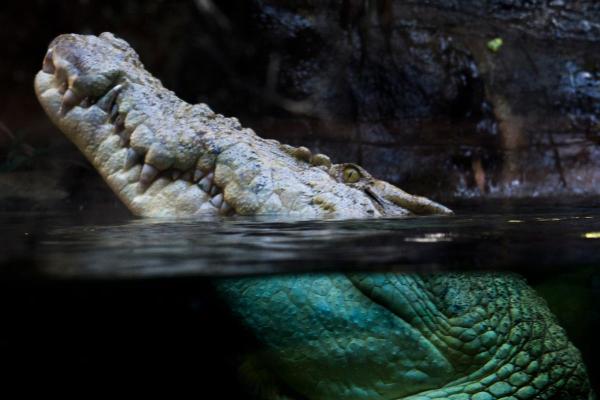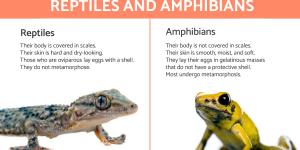Are Crocodiles Classified as Amphibians or Reptiles?


The origins of reptiles can be traced back to approximately 312 million years ago. One of the crucial evolutionary adaptations that allowed this group to become independent of aquatic environments was the development of an egg with a protective shell. This innovation made it possible for reptiles to lay eggs on dry land, eliminating the need for water-dependent reproduction, unlike amphibians. Reptiles, as a taxonomic group, boast a remarkable diversity, with around 12,000 identified species. Among these species, we find the Crocodilia order, which scientific advancements have revealed to be closely related to birds, classifying them as sister taxa.
In this AnimalWised article, we aim to address the question of whether crocodiles are reptiles or amphibians.
Is the crocodile reptile or amphibian?
It is not uncommon for people to confuse crocodiles with amphibians due to certain physical similarities they share with frogs and toads. For instance, crocodiles have a semi-aquatic lifestyle, dividing their time between water and land. Additionally, they possess a moist skin, which can superficially resemble the skin of amphibians.
These resemblances can lead to the misperception that crocodiles fall under the category of amphibians. However, it is important to note that crocodiles are, in fact, reptiles with distinct characteristics, belonging to the class Reptilia, which sets them apart from amphibians in terms of their evolutionary traits and biological features.
Within the broader Reptilia class, the crocodile belongs to the Crocodilia order, home to various species known for their impressive size, semiaquatic lifestyles, and prominent role as predatory animals in their ecosystems. As such, it is accurate to describe crocodiles as large reptiles.
Advancements in scientific knowledge and the emergence of cladistics, a classification system based on species' evolutionary relationships, have shed new light on the relationship between crocodiles and birds. Notably, these two groups, birds and crocodiles, are recognized as sister taxa, indicating a close evolutionary bond between them. In the context of cladistics, the term "reptile" has been replaced by "Sauropsida," defining the name of the clade encompassing both crocodiles and birds.
Now that we understand that the crocodile is indeed a reptile, let us delve deeper into the reasons that place it within this category. By exploring the specific evolutionary, anatomical, and physiological characteristics that define crocodiles as reptiles, we can gain a more comprehensive understanding of their unique place in the natural world.
In addition to addressing whether crocodiles are reptiles or amphibians, we also want to shed light on another common misconception: the belief that crocodiles are lizards. In our other article, we explain how crocodiles and lizards differ, providing a comprehensive explanation to alleviate this confusion.
Why is the crocodile a reptile?
The classification of animals based on anatomical features, particularly at the level of the skull, provides valuable insights into their evolutionary relationships.
Among these groups, we have the synapsids, which encompass mammals and their extinct relatives. One of the distinguishing features of synapsids is the presence of a hole on each side of the skull, located behind the eye socket.
On the other hand, the sauropsids form the other major group, comprising all reptiles. Within the sauropsids, we find the diapsids, which are characterized by having two temporal fossae on each side of the skull, also positioned behind the eye socket. It is within this framework that the crocodile's classification as a reptile becomes evident, as it possesses this typical anatomical characteristic of the group.
Several other distinctive features identify the crocodile as a reptile:
- Reproduction via a shelled amniotic egg: this adaptation allows crocodiles to lay eggs on land, reducing their dependence on aquatic environments for reproduction.
- Internal fertilization: crocodiles, like other reptiles, engage in internal fertilization, providing increased protection and survival chances for the developing embryos.
- Strong and highly keratinized skin: the crocodile's tough skin provides protection and aids in minimizing water loss in their semiaquatic habitats.
- Large and powerful jaw muscles: crocodiles possess formidable jaw muscles that enable them to seize and crush their prey effectively.
- Breathing through lungs: despite some reptiles being capable of limited gas exchange through gills, crocodiles primarily breathe through their lungs, allowing them to adapt to both aquatic and terrestrial environments.
- Ectothermy: like many reptiles, crocodiles are ectothermic, relying on external heat sources to regulate their body temperature. However, some reptiles exhibit partial temperature regulation capabilities.
- Advanced nervous system: compared to amphibians, reptiles, including crocodiles, have a more developed and sophisticated nervous system, contributing to their enhanced sensory perception and motor skills.
These combined features firmly place crocodiles within the reptilian category and contribute to their unique adaptations, making them well-suited to thrive in diverse habitats. Curious about reptiles and how they differ from amphibians? Check out our other article that breaks down the key distinctions between these two fascinating groups.

What kind of reptile is the crocodile?
The Reptilia class, within the traditional classification, encompasses various orders, one of which is Crocodilia. This order comprises three families: Alligatoridae, Gavialidae, and Crocodylidae. Although all these groups are commonly referred to as crocodiles, they are distinct from one another, each containing unique species.
We find the alligators within the family Alligatoridae, followed by the gharials and false gharials in the Gavialidae family, and lastly, the true crocodiles in the Crocodylidae family.
Molecular studies aimed at establishing evolutionary relationships and determining which families are closer to each other have yielded contradictory results, necessitating further investigations to better understand the connections between alligators, gharials, and true crocodiles.
When we focus on true crocodiles, we observe a few distinguishing characteristics that set them apart from their relatives:
- Distribution: true crocodiles are primarily found in regions spanning parts of Africa, India, Sri Lanka, Southeast Asia, the East Indies, Australia, Mexico, Central America, the West Indies, and northern South America.
- Genera and species: they are classified into three genera and consist of approximately 14 to 17 species, depending on the source of information.
- Interdigitated teeth: the teeth of the upper and lower jaw form an interdigitated row when the mouth is closed, making their teeth visible even in this position.
- Protruding fourth tooth: in the crocodile, the fourth tooth on each side of the lower jaw protrudes from the snout when the mouth is closed, thus remaining visible.
- Head shape: true crocodiles have a narrower and longer head compared to the other families.
- V-shaped snout: their snout exhibits a more V-shaped appearance, as opposed to the U-shaped snouts found in other families.
- Membranes on hind leg fingers: They possess membranes on the fingers of their hind legs, a feature not present in other groups.
- Specialized glands for salt filtration: True crocodiles have specialized glands that enable them to filter salt, making them more tolerant of saltwater ecosystems.
- Aggressive behavior: Species within the Crocodylidae family tend to be more aggressive than their counterparts in other families.
- Size: Typically, crocodiles are larger than alligators and gharials. The Crocodylidae family includes the largest member of the entire group, the saltwater crocodile (Crocodylus porosus), which can exceed 6 meters in length and weigh over a ton.
True crocodiles possess unique characteristics that make them stand out and adapt remarkably to their environments. To learn more fascinating facts about them, check out our other article on ten intriguing crocodile facts.
If you want to read similar articles to Are Crocodiles Classified as Amphibians or Reptiles?, we recommend you visit our Facts about the animal kingdom category.
- Hickman, C., Roberts, L., Parson A. (2000). Comprehensive principles of zoology . McGraw Hill Inter-American: Spain.
- ITIS. (2023). Crocodylidae . Available at: https://www.itis.gov/servlet/SingleRpt/SingleRpt?search_topic=TSN&search_value=174359#null
- Wermuth, H. Fritz and Ross, . James P. (2023). Crocodile . Encyclopedia Britannica. Available at: https://www.britannica.com/animal/crocodile-order






